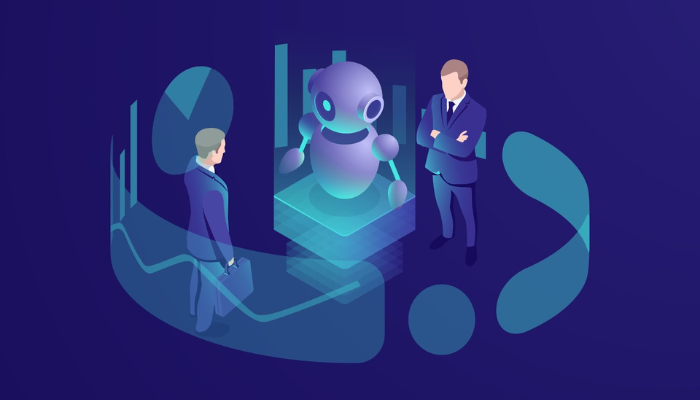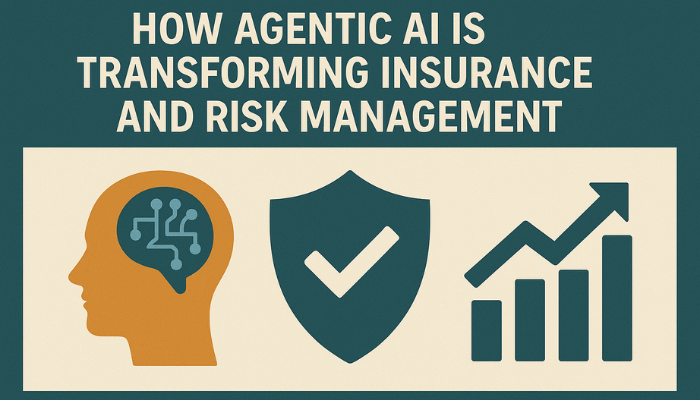AI agents are emerging as essential tools for boosting efficiency in logistics, manufacturing, and finance. Enterprises are using them to automate decisions, manage workflows, and respond to disruptions in real time. Yet, scaling AI remains difficult. Over 80 percent of projects fail, and fewer than half reach production. One reason is that general-purpose AI often lacks the industry-specific insight required for mission-critical operations.
That’s why businesses are moving toward domain-specific agentic AI, autonomous systems built to operate within the unique rules, data, and decisions of a specific industry. These agents go beyond analysis. They act with context, align with KPIs, and learn from feedback.
This blog explores how domain-specific agentic AI fills the gap left by generic models and how it’s already driving accuracy, resilience, and ROI across enterprise systems.
What Is Domain-Specific Agentic AI?
Domain-specific agentic AI refers to intelligent systems engineered to operate autonomously within the constraints, data formats, and decision frameworks of a specific industry. These agents go beyond task execution. They independently perceive situations, generate plans, take actions, and adapt to feedback in live enterprise environments.
Generic AI systems often struggle in enterprise environments because they lack domain depth. While they may perform well on benchmark datasets, they fall short in real-world conditions that require understanding specific workflows, constraints, and compliance norms.
Why Enterprises Need Domain-Specific Agents
A one-size-fits-all model that flags a delivery delay may not know whether to prioritize air freight, reroute via a backup hub, or renegotiate terms with the client. Without contextual intelligence, these systems become passive observers rather than active decision-makers.
Domain-specific agents bridge this gap by encoding business logic into their architecture. For instance:
- A logistics agent can weigh trade-offs between route costs, lead times, and customs risks while coordinating with warehouse inventory and customer SLAs.
- A clinical agent not only understands patient flow and appointment slots but also triage urgency, doctor licensing rules, and equipment constraints.
This ability to embed domain-specific reasoning directly improves decision quality. Enterprises are no longer just analyzing data. They are acting on it intelligently and immediately.
According to Gartner, by 2026, 30% of enterprises will use AI agents that adapt to organizational context and deliver measurable process improvements. McKinsey similarly notes that the highest AI returns are seen in companies that tailor systems to their operational verticals, not just deploy generic platforms.
These findings make one thing clear: domain-specific agentic AI is not a future concept. It is the new standard for scaling intelligence in complex, regulated, high-stakes business systems.
Want agents that think like your operations team? See how Codewave builds domain-aware systems that align with your KPIs.
[Explore our AI development services]Key Capabilities and Architecture of Domain-Specific Agents
Unlike generic bots or workflow engines, domain-specific agentic systems are structured for autonomy in complex business environments. Their architecture supports context-sensitive decision-making, high system interoperability, and continuous self-improvement.
1. Goal-Oriented Reasoning Modules
Each agent is aligned with a narrow operational objective, such as reducing last-mile delivery delays or maintaining clinical throughput. These goals shape how agents prioritize decisions, respond to constraints, and manage trade-offs dynamically.
2. Contextual Data Binding
Agents don’t operate on isolated data sets. They ingest signals from structured systems (ERP, EHR, CRM), semi-structured inputs (emails, support tickets), and real-time feeds (IoT telemetry, market APIs). Contextual interpretation is built into the model layer, enabling the agent to adjust strategies based on evolving conditions.
3. Decision Engines with Feedback Loops
Whether using reinforcement learning or rule-based planning, agents rely on decision logic that adapts over time. Feedback loops allow them to compare actual outcomes with expected ones and refine future actions accordingly. This architecture supports both reactivity and learning in live environments.
4. Micro-Agent Composition
In many enterprise scenarios, a single domain is too complex for one monolithic agent. Instead, systems are built from smaller, focused agents that handle discrete functions, like a demand forecast agent feeding into a pricing agent. This micro-agent approach enhances modularity and resilience.
5. API-First Integration
To act autonomously, agents must interface deeply with enterprise systems. They are built on robust, secure APIs that allow them to write back to ERPs, dispatch work orders, generate reports, or escalate tasks without manual input. Tight integration is what turns analysis into real-world action.
This architecture ensures that domain-specific agents not only understand your environment but actively participate in it, making them fit for high-volume, high-stakes enterprise use.
Also read: Building Agentic AI Systems in Python
Enterprise Use Cases for Domain-Specific Agentic AI
Domain-specific agents are transforming enterprise workflows by enabling context-aware decisions in real time. Below are targeted applications, each illustrated with a practical use case that shows how intelligent agents deliver operational impact.
Supply Chain Operations
Agents coordinate across inventory, procurement, and logistics to adapt quickly to disruptions.
Example: A consumer electronics company deployed agents to detect supplier delays and reroute shipments through alternative hubs, ensuring key product launches remained on schedule.
Healthcare Administration
Agents help hospitals manage patient flows, staff allocations, and regulatory tasks.
Example: A multi-hospital network uses scheduling agents to allocate operating rooms and specialists dynamically, reducing idle time and improving patient throughput during peak hours.
Financial Services
Agents assist in real-time transaction analysis, risk assessment, and portfolio adjustments.
Example: A fintech platform embedded an agent that reviews loan applications against internal risk thresholds and public credit datasets, allowing for near-instant pre-approvals without compromising underwriting quality.
Manufacturing and Maintenance
Agents monitor machine telemetry and adjust production based on upstream and downstream signals.
Example: A precision parts manufacturer uses agents to detect deviations in vibration data and trigger proactive maintenance scheduling, avoiding production halts.
Customer Experience Platforms
Agents support dynamic user engagement by tracking usage patterns and adjusting outreach.
Example: An enterprise SaaS firm uses an agent to monitor client feature adoption and trigger tailored onboarding emails or support prompts, improving overall account health.
Each of these examples demonstrates more than automation. They show how intelligent agents can act on domain-specific context, reduce human load, and continuously improve as conditions evolve.
Is your workflow reactive, not proactive? Codewave’s agentic systems help enterprises move from manual response to real-time orchestration.
[Book a workflow audit]How to Design and Deploy Domain-Specific Agents
Designing domain-specific agentic systems requires more than pretrained models or generic APIs. For enterprise-grade use cases, you need agents that operate with contextual precision, integrate into operational systems, and adapt continuously based on real-world feedback.
1. Identify High-Impact Decision Bottlenecks
Start by isolating workflows where variability is high and decision latency is costly. These might include load balancing across transport nodes, real-time approval of financial transactions, or routing clinical tasks based on urgency and availability. Focus on areas where automation can reduce cycle time without compromising decision quality.
2. Define Policy Functions Tied to KPIs
Agents must optimize for measurable business objectives. Use policy functions that encode goals such as reducing average resolution time, increasing on-time delivery rates, or maintaining regulatory compliance thresholds. Define action spaces, state observables, and feedback metrics that reflect operational truth.
3. Hardwire Domain Constraints Into Planning Logic
Generic agents fail when real-world rules are ignored. Define constraints such as vendor SLAs, regulatory checks, or critical-path dependencies directly into the agent’s planner. Use symbolic constraints, rule engines, or structured data validation to enforce domain boundaries on every decision cycle.
4. Simulate Against Edge Cases and Historical Logs
Before live deployment, test agents against synthetic edge scenarios and production logs. Replay rare events, incomplete data streams, and cascading failures to see how agents react. Validate fallback behavior, escalation triggers, and overall system stability.
5. Integrate Directly With Execution Systems
Use secure APIs or event-driven architectures to connect agents with ERP systems, transport management systems, or EMR platforms. Avoid deploying agents in isolation from the execution layer. Agents must not only decide, they must act through the systems already in place.
6. Deploy Gradually With Escalation Paths
Start with human-in-the-loop oversight. Let agents recommend actions while teams monitor outputs. Gradually enable autonomous execution in low-risk zones, while keeping manual override and escalation protocols active. Always log decisions, inputs, and actions for auditability and trust.
7. Enable Feedback Loops for Adaptation
Build pipelines that allow agents to ingest new performance data and adjust policies or strategies accordingly. This may involve tuning parameters, refining constraints, or adapting heuristics based on post-decision outcomes. The goal is to continuously improve while minimizing operational risk.
Also read: Top MLOps Tools and Platforms: Key Features You Need to Know
Evaluating ROI and Business Value of Domain-Specific Agentic AI
Enterprise leaders investing in AI expect tangible outcomes, not just model accuracy. With domain-specific agentic AI, returns are measurable in process improvements, reduced intervention, and accelerated throughput. But to capture real value, you need to evaluate ROI through operational lenses.
1. Frame ROI Around Decision Quality and Latency
Generic ROI calculations often miss what domain-specific agents truly impact; decision precision and cycle time. In a procurement workflow, for instance, an agent reducing supplier selection time by 60 percent while maintaining quality scores leads to faster time-to-contract and better negotiated terms.
2. Track Workflow-Specific KPIs
Success should be tied to KPIs already used by operations teams. These may include:
- Inventory turnover rate for supply chain agents
- Average resolution time in service operations
- Missed appointment rate for clinical scheduling agents
- SLA compliance rate in logistics orchestration
By benchmarking agent decisions against these KPIs, you create a direct line from AI investment to business outcome.
3. Quantify Cost Savings and Resource Reallocation
Every agent deployed reduces the need for manual review or repetitive decisioning. Calculate savings from fewer overtime hours, reduced exception handling, or minimized third-party resolution costs. In parallel, track where freed-up talent is redeployed into higher-value activities.
4. Use Simulation-Driven Value Forecasting
Before rollout, simulate agent behavior under real operating conditions using historical or synthetic datasets. Project expected savings, response improvements, and reduction in error rates across different workflow tiers. This simulation-driven approach helps validate value before full-scale integration.
5. Account for Risk Reduction as a Value Lever
Agents trained with domain rules can reduce non-compliance penalties, catch risk conditions earlier, and avoid costly errors. For example, in regulated industries like finance or healthcare, risk avoidance itself becomes a core component of ROI.
ROI Example
Consider a multi-agent deployment across a regional supply chain:
- Annual logistics spend: $10 million
- Agent-driven optimization reduces route inefficiencies by 7 percent
- Estimated savings: $700,000 annually
- Deployment and ops cost: $180,000
- ROI = ((700,000 − 180,000) / 180,000) × 100 = 289 percent
This kind of ROI is common when agents are tightly aligned with domain-specific decision logic and can operate at scale.
Unsure how to quantify AI ROI? We help enterprise teams map agents to business outcomes before writing a single line of code.
[Talk to an AI strategist]Risks and Governance Considerations
Deploying domain-specific agentic AI brings major benefits, but also risks that must be carefully managed, especially in regulated, high-impact industries. Here’s what to watch for:
- Data Bias and Overfitting: Agents trained on narrow or incomplete data may develop blind spots or biased logic. Continuous testing, synthetic data, and regular updates help correct this.
- Uncontrolled Automation: Without safeguards, agents might make decisions beyond their scope, like rerouting critical inventory or denying loans incorrectly. Clear rules and human oversight are essential.
- Security and Compliance Gaps: Agents access sensitive data and systems, increasing exposure to breaches. Role-based access, secure APIs, and compliance with standards like HIPAA or PCI-DSS are non-negotiable.
- Lack of Transparency: If agents can’t explain their decisions, trust and audit readiness suffer. Use logs, rationale traces, and override options to maintain accountability and control.
Also read: AI Tools for Small Businesses: Applications and Efficiency
Why Codewave for Domain-Specific Agentic AI Solutions
Deploying domain-specific agents is not just a model-building exercise. It requires orchestration across AI design, enterprise systems integration, human-centered controls, and ongoing operational tuning. At Codewave, we specialize in translating strategic AI goals into tangible, scalable systems that work in your environment.
- Deep Domain-AI Engineering Expertise: Our teams bring technical fluency in agent-based design, reinforcement learning, graph planning, and LLM orchestration. More importantly, we understand the nuances of enterprise operations, whether it’s smart scheduling in hospitals or real-time procurement in global supply chains.
Explore our Agentic AI Product Design and Development Services to see how we help you move from static automation to intelligent, adaptive ecosystems.
- Built for Complex Enterprise Environments: Codewave doesn’t just build agents. We integrate them into live workflows; working with your ERP, IoT, CRM, or warehouse systems. Our modular deployment model allows you to introduce agents incrementally and scale confidently.
- Human-Centric, Auditable Systems: Autonomous does not mean opaque. We design every agent with explainability, audit trails, and override mechanisms from day one. This ensures your team always understands, controls, and trusts what the system is doing.
- Continuous Co-Evolution: Agents deployed in production need to evolve. Our MLOps practices ensure continuous retraining, feedback loop tuning, and performance benchmarking. We don’t just ship AI; we stay with you to operationalize it.
Let’s talk about your enterprise AI strategy.
Schedule a 30-minute strategy session with our AI experts!
Codewave is a UX first design thinking & digital transformation services company, designing & engineering innovative mobile apps, cloud, & edge solutions.






